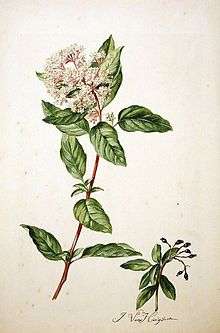Viburnum tinus
Viburnum tinus (laurustinus or laurustine) is a species of flowering plant in the family Adoxaceae, native to the Mediterranean area of Europe and North Africa. Laurus signifies the leaves' similarities to bay laurel.
| Viburnum tinus | |
|---|---|
 | |
| Viburnum tinus by L. By Jacob van Huysum | |
| Scientific classification | |
| Kingdom: | Plantae |
| Clade: | Tracheophytes |
| Clade: | Angiosperms |
| Clade: | Eudicots |
| Clade: | Asterids |
| Order: | Dipsacales |
| Family: | Adoxaceae |
| Genus: | Viburnum |
| Species: | V. tinus |
| Binomial name | |
| Viburnum tinus | |
| Synonyms | |
Description

It is a shrub (rarely a small tree) reaching 2–7 m (7–23 ft) tall and 3 m (10 ft) broad,[1] with a dense, rounded crown. The leaves are evergreen, persisting 2–3 years, ovate to elliptic, borne in opposite pairs, 4–10 cm long and 2–4 cm broad, with an entire margin.
The flowers are small, white or light pink, produced from reddish-pink buds in dense cymes 5–10 cm diameter in the winter. The fragrant flowers are bisexual and pentamerous. The flowering period is in winter, or from October to June in the northern hemisphere. The five petals are tubular, with rounded, rounded corolla lobes and pink in the bud, later white. There is only one circle with five stamens. Pollination is by insects. The fruit is a dark blue-black drupe 5–7 mm long.
Leaves have domatia where predatory and microbivorous mites can be housed.[2]
Habitat
It grows mainly in the Mediterranean Maquis shrubland and in oak forests. It prefers shady, moist areas, at an altitude of 0–800 metres (0–2,625 ft) above sea level. It is native to the Mediterranean basin: North Africa (Algeria, Morocco, Tunisia, Libya), Near East (Israel, Lebanon, Turkey), Southern Europe (Portugal, Spain, France, Italy, Albania, Greece). Also found in the Azores and the Canary Islands.
Cultivation
Viburnum tinus is widely cultivated for its winter blooms and metallic blue berries. It is hardy down to −10 °C (14 °F). The cultivars ‘Eve Price’,[3] ‘French White’[4] and ‘Gwenllian’[5] have gained the Royal Horticultural Society’s Award of Garden Merit.[6]
Other uses
V. tinus has a very beneficial medicinal property. The active ingredients are viburnin (a substance or more probably a mixture of compounds) and tannins. Tannins can cause stomach upset. The leaves when infused have antipyretic properties. The fruits have been used as purgatives against constipation. The tincture has been used lately in herbal medicine as a remedy for depression. The plant also contains iridoid glucosides.[7]
Pests
In south-east Britain Viburnum tinus is the principal host of the viburnum beetle (Pyrrhalta viburni), the country's "number one pest species" according to the Royal Horticultural Society.[8]
Subspecies
There are three subspecies:
- Viburnum tinus subsp. tinus. Mediterranean region.
- Viburnum tinus subsp. rigidum (syn. V. rigidum). Canary Islands.
- Viburnum tinus subsp. subcordatum. Azores.
References
- RHS A-Z encyclopedia of garden plants. United Kingdom: Dorling Kindersley. 2008. p. 1136. ISBN 1405332964.
- Plants, mites and mutualism: leaf domatia and the abundance and reproduction of mites on Viburnum tinus (Caprifoliaceae). Raul Grostal and Dennis J. O'Dowd, Oecologia, April 1994, Volume 97, Issue 3, pages 308-315, doi:10.1007/BF00317319
- "RHS Plantfinder - Viburnum tinus 'Eve Price'". Retrieved 18 February 2019.
- "RHS Plantfinder - Viburnum tinus 'French White'". Retrieved 18 February 2019.
- "RHS Plantfinder - Viburnum tinus 'Gwenllian'". Retrieved 18 February 2019.
- "AGM Plants - Ornamental" (PDF). Royal Horticultural Society. July 2017. p. 107. Retrieved 18 February 2019.
- Iridoid glucosides from Viburnum tinus. Lamberto Tomassini, M. Francesca Cometa, Sebastiano Foddai and Marcello Nicoletti, Phytochemistry, January 1995, Volume 38, Issue 2, Pages 423–425, doi:10.1016/0031-9422(94)00618-4
- "Top 10 pests". Wisley, England: Royal Horticultural Society. 19 January 2011. Archived from the original on October 9, 2013. Retrieved 10 May 2011.
External links
| Wikimedia Commons has media related to Viburnum tinus. |
- Flora Europaea: Viburnum tinus
- Eriksson, O., et al. 1979. Flora of Macaronesia: checklist of vascular plants
- Pignatti S. - Flora d'Italia – Edagricole – 1982, Vol. II, pag. 639
- Biolib
- Viburnum tinus
Gallery
- Plant
 Inflorescence
Inflorescence- Close-up on flowers
 Unripe fruits
Unripe fruits- Ripe fruits
- Close-up on fruits
- Leaf
